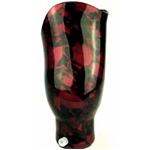
Technology
Unlike conventional prosthetic suspension methods like pin systems, lanyards, suction liners & adjustable sockets, 5280 hypobarric socket technology increases tissue profusion, physiologically improving limb health.
Tissue Perfusion
Having a healthy residual limb starts here.
 Tissue perfusion socket technology pulls tissue to the socket wall
Tissue perfusion socket technology pulls tissue to the socket wall
Puck technology helps pull blood, lymph and nutrients flow into your residual limb, making tissue healthier and stronger.
Tissue Compression
 Other suspensions (tissue compression) pin, sleeve, lanyard & suction liners compresses healthy tissue constricting blood flow
Other suspensions (tissue compression) pin, sleeve, lanyard & suction liners compresses healthy tissue constricting blood flow
Conventional suspension technology requires the amputees to progressively tightening the socket either by adding socks or further compressing the residual limb as essential limb fluid & volume is lost through out the day.
 Additional Benefits of 5280 Puck HypoBarric Socket Technology
Additional Benefits of 5280 Puck HypoBarric Socket Technology
- Maximum socket stability with lower trim lines
- Moisture evacuates
- Reduce friction and movement to tissue
- Soft distal interface to maximize comfort
- Rotation control
- Ability to heal lesions
- Ability to suspend heavier components
- Improved gait dynamics
- Better feeling of where your limb is in space (Proprioception)
- Feel connected to your prosthesis
- Improved circulation
- No pistoning
- Feeling of reduced weight.
- Unparalleled suspension
 5280 was founded by Clinical Prosthetists seeking to solve some of the most frustrating issues with existing socket technology and the all to common problems with elevated vacuum. Frustrated by external vacuum systems that perpetually leaked, produced fluctuating levels and limited foot choice. We designed the first Internal intelligent socket system with integrated elevated vacuum technology that can actually make you feel like your prosthesis is a part of you.
5280 was founded by Clinical Prosthetists seeking to solve some of the most frustrating issues with existing socket technology and the all to common problems with elevated vacuum. Frustrated by external vacuum systems that perpetually leaked, produced fluctuating levels and limited foot choice. We designed the first Internal intelligent socket system with integrated elevated vacuum technology that can actually make you feel like your prosthesis is a part of you.

Puck Technology. The Secret is Inside (Literally)
PUCKS are internal vacuum systems (The entire vacuum pump is contained inside the socket).
This is why pucks work so much better than external vacuums because the puck is inside the negative pressure environment there is no place to leak vacuum.
The Internal Vacuum difference & Why Internal Is Better…
 USER ADJUSTABLE.
USER ADJUSTABLE.
Select the vacuum level that feels right for you.
 WIDER FOOT SELECTION.
WIDER FOOT SELECTION.Due to low puck build height, pucks are the lowest build height in the industry. Which means more component choice when selecting prosthetic knees and feet.
 STREAM LINED AND PROTECTED
STREAM LINED AND PROTECTEDBecause the puck is actually inside the socket, your system is safe from impacts, dust, water etc.
 SELF SEALING DESIGN
SELF SEALING DESIGNMakes your socket air tight.
 SOFT DISTAL END
SOFT DISTAL END
Interface option improves comfort 100%.
 LIGHT WEIGHT
LIGHT WEIGHT
and located close to the socket so there is no pendulum effect.
 FULL VACUUM
FULL VACUUMfrom step one. Walking is not necessary to achieve vacuum.
 BUILT IN NEGATIVE PRESSURE TANK
BUILT IN NEGATIVE PRESSURE TANKThis reservoir add extended vacuum life to the socket.
 NO LEAKY ATTACHMENT PLATES
NO LEAKY ATTACHMENT PLATESThis is common way to port the vacuum line into the socket. Over a short period of time they loosen up & can begin to leak vacuum.
 NO HOSES OR PORTS
NO HOSES OR PORTSThere is no where your Puck can leak vacuum other than the sleeve or sealing liner.
How the Other Guys Do it… They use Ports, Plates, and Hoses.
All of which can contribute to leaks and fluctuating vacuum levels in your socket.

Porting In With a Hole / Valve Drilled Into Socket Wall With a Hose Running To Vacuum Pump
 Lamination Plate That is Sandwiched Between the Inner & Outer Laminations
Lamination Plate That is Sandwiched Between the Inner & Outer Laminations
UNDERSTANDING Problems with Traditional External Electric & Mechanical Vacuums (weight / motion activated vacuum pumps)
Mechanical Vacuums often provide a fluctuating level of vacuum through out the day due to the large number of leak points in the system. This makes the Prosthesis feel loose and disconnected after short periods of rest.
 MECHANICAL PUMPS REQUIRE MULTIPLE STEPS
MECHANICAL PUMPS REQUIRE MULTIPLE STEPS
User must walk a number of steps before vacuum is achieved in the socket. The Prosthesis will feel loose as user begins walking, until the vacuum level rises.
 PISTONING
PISTONINGMechanical Pumps allow the limb to piston up and down inside the socket until vacuum is achieved.
 PUMP BLEED
PUMP BLEEDNo matter what external vacuum pump, the fittings, connections and valves inside the pump all bleed vacuum.
 NO ADJUSTMENT
NO ADJUSTMENTMechanical vacuums have one vacuum level and that’s it!
 LACK OF FOOT CHOICE
LACK OF FOOT CHOICEeither because the foot is the actual vacuum pump OR the Vacuum Pump is inline (located between the socket and foot), this takes up valuable space and does NOT allow for higher clearance feet that offer more energy return.
 LEAKY HOSES
LEAKY HOSES
Need we say more… Who wants a hose running up their leg anyway?
 LEAKY SOCKET PORTS
LEAKY SOCKET PORTSinstalled through the socket wall are a consistent source of vacuum leaks.
 LEAKY ATTACHMENT PLATES
LEAKY ATTACHMENT PLATESThis is common way to port the vacuum line into the socket. Over time these plates can loosen up and cause vacuum leaks.
 BUILT IN VACUUM RANGE
BUILT IN VACUUM RANGE
Most External electric pumps have a built in range (a time delay to stop the pump from turning on until the vacuum level drops below a certain level). This creates the illusion the vacuum level is staying the same… when in fact it is fluctuating and leaking vacuum.
 WEIGHT
WEIGHTMechanical Pumps can be heavy. The farther the Pump is from the socket the heavier it will feel. (pendulum effect)
Understanding Vacuum Signatures
 5280 PROSTHETICS Constant Vacuum Systems
5280 PROSTHETICS Constant Vacuum Systems
SmartPuck Technology (Blue) maintains a CONSTANT vacuum level in the socket at all times. The entire vacuum system is located inside the socket (negative pressure environment) making the SmartPuck the most air tight vacuum system in the industry. ON Demand Puck technology (Green) utilizes a negative pressure reservoir to extend the vacuum life of the socket all day.
 THE OTHER GUYS External Vacuums Fluctuate in Vacuum Level
THE OTHER GUYS External Vacuums Fluctuate in Vacuum Level
Mechanical vacuums produce an “All or None” signature. Meaning that you have no ability to lower or adjust your vacuum level which is critical because no two amputees are the same. Vacuum typically bleeds out of the socket when the user is at rest. Because the system is external it is more prone to vacuum leaks. Complete vacuum bleed out can occur in as little as two hours. Mechanical systems allow the limb to piston inside the socket before vacuum is achieved by ambulating.
 THE OTHER GUYS External Vacuums Fluctuate in Vacuum Level
THE OTHER GUYS External Vacuums Fluctuate in Vacuum Level
External electric vacuums typically operate in a set range. The set range is a delay in how much vacuum can be lost before the vacuum pump turns back on. External systems bleed vacuum from hoses, adaptor plates and actual fittings within the pump itself. The delay creates the perception the socket is not loosing vacuum and turning on as frequently. Some External electric pumps cannot start against back pressure and require a drop in pressure in order to restart the pump.
